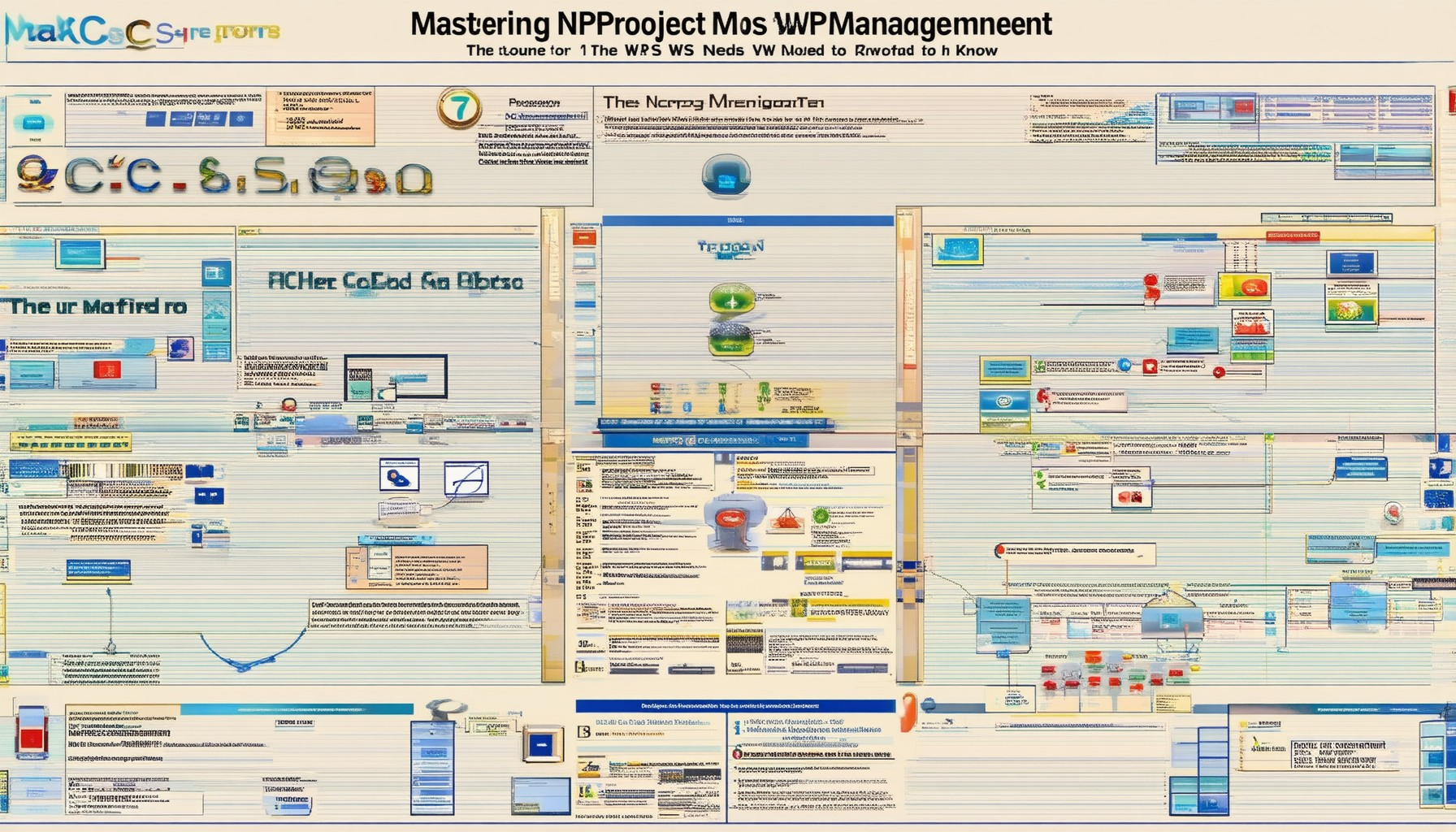Effective project management is a cornerstone of success for nonprofit organizations, where resources are often limited and goals are mission-driven. In this guide, we delve into the essential principles of NPO (Nonprofit Project Management) to help you master the complexities of managing projects in this unique sector. From understanding the 5 Cs of project management—Communication, Choice of methodologies, Consistency, Collaboration, and Control—to grasping the 5 Ws, including Who, What, When, and Why, this article equips you with actionable tips and strategies to streamline operations and achieve your organizational objectives. Whether you’re new to nonprofit project management or looking to refine your existing approach, this comprehensive overview will provide you with the tools and insights needed to drive meaningful impact. Explore how successful project management can overcome common nonprofit challenges, align projects with organizational goals, and empower your team to deliver results. Read on to discover how to leverage NPO strategies and best practices to ensure your nonprofit thrives in an ever-evolving landscape.
Understanding the Main Purpose of NPO
An NPO, standing for Nonprofit Organization, exists to serve the public interest by operating programs and services that benefit society. Unlike for-profit entities, NPOs prioritize public welfare over profitability, focusing on addressing societal needs through various initiatives. Their activities encompass a wide range of sectors, including education, healthcare, arts, environment, and social justice, aiming to enhance community life and improve quality of life for individuals and communities.
Key characteristics of NPOs include reliance on donations, grants, and volunteer work for funding and operational support. They often face challenges such as limited resources, requiring efficient resource allocation and strong transparency measures. NPOs typically have a board of directors overseeing operations and utilize volunteers or paid staff to execute programs. Fundraising is crucial for sustained initiatives, necessitating effective communication and relationship-building skills.
In project management, NPOs may adopt methodologies like Agile or Scrum to handle complex projects, emphasizing collaboration with stakeholders and adaptive planning. Despite these efforts, challenges like funding limitations and dependency on external factors persist. However, NPOs’ commitment to measuring impact through data collection and demonstration of results aids in securing continued support.
In essence, NPOs are vital drivers of social change, providing essential services and fostering community engagement. Their mission-oriented approach contributes significantly to societal well-being, highlighting their crucial role in creating a more equitable and compassionate world.

What are the 5 Cs of Project Management?
- Criteria: These are the standards, measurements, or benchmarks used to evaluate the success or completion of a project. They define what needs to be achieved and how progress will be measured.
- Constraints: These are limitations or boundaries that influence how a project is planned and executed. They can include time, budget, resource availability, and regulatory requirements.
- Customers: Refers to the end-users or stakeholders who have the most interest in the project’s outcome. Their needs, expectations, and feedback are crucial for project success.
- Cost: This involves the financial resources allocated to the project, including planning for budgets, tracking expenses, and managing costs to stay within limits.
- Controls: These are mechanisms or processes put in place to monitor and manage the project’s progress, ensure adherence to plans, and address any deviations or issues that arise.
What Does a Project Manager Do in a Non-Profit Organization?
A project manager in a non-profit organization plays a pivotal role in ensuring the smooth operation and success of various initiatives. Their responsibilities span across multiple domains, from organizational support to strategic planning, all aimed at achieving the organization’s mission.
Key Responsibilities
- Logistical Support: Organize and facilitate meetings, prepare necessary materials, and manage event logistics such as venue bookings and attendee coordination.
- Database Management: Maintain and update internal databases to track communications, donor information, and development activities, ensuring accuracy and accessibility.
- Strategic Planning: Assist in setting project goals, timelines, and milestones, aligning these with the organization’s broader objectives.
- Stakeholder Engagement: Coordinate with key stakeholders, including board members, donors, and volunteers, to foster collaboration and alignment with organizational goals.
- Resource Allocation: Manage budgets, assign tasks, and allocate resources effectively to ensure projects are completed efficiently and within scope.
- Risk Management: Identify potential risks and implement mitigation strategies to prevent project delays or failures.
- Documentation and Reporting: Keep detailed records of decisions, actions, and outcomes to ensure transparency and accountability.
Importance of Project Management in Non-Profits
In non-profit settings, effective project management is crucial for maximizing impact and staying within financial constraints. By streamlining operations and fostering collaboration, project managers enable organizations to focus on their core missions while maintaining operational efficiency.
Resources and Tools
To excel in their roles, non-profit project managers can leverage tools and resources available through platforms like NPO Expert , which offers comprehensive guides, templates, and best practices tailored for non-profit professionals. By understanding these responsibilities and leveraging the right resources, project managers in non-profits can contribute significantly to the success and sustainability of their organizations.

The 5 W’s of Project Management
Project management revolves around answering the fundamental questions of any initiative, which are commonly referred to as the 5 W’s and an H:
- What: Defines the objectives and deliverables of the project. Ensures everyone understands the scope and goals.
- When: Sets the timeline, including key milestones and deadlines, to keep the project on schedule.
- Where: Identifies the location(s) where the project will take place, whether physical or virtual.
- Who: Identifies the stakeholders, team members, and their respective roles and responsibilities.
- Why: Explains the purpose and benefits of the project, aligning it with organizational goals and securing stakeholder support.
- How: Outlines the methods and processes used to execute the project, including tools, techniques, and communication strategies.
By systematically addressing each of these components, project managers can ensure effective planning, execution, and delivery, leading to successful project outcomes.

Understanding NPO in Project Management
NPO can stand for several different concepts depending on the context, particularly in project management. Here are some common interpretations:
- Nonprofit Organization (NPO): In many cases, NPO refers to a Nonprofit Organization, which operates independently of government or profit motives. These organizations often engage in project management to further their missions and goals.
- Network Planning Office: This could refer to a department or office responsible for overseeing network-related planning within a project or organization.
- New Product Development: In some contexts, NPO may be used to denote New Product Development, focusing on the creation and introduction of new products or services.
- Nuclear Power Operations: This is a less common interpretation and typically relates to the energy sector, not directly to project management.
In the context of project management, the meaning of NPO often depends on the industry and the specific project being managed. Understanding the context is crucial to accurately interpret the acronym and its application.
For more resources on effectively managing projects within nonprofit organizations, visit our NPO Expert website. We provide comprehensive guides, tools, and strategies tailored to the unique challenges faced by nonprofit organizations.
What is NPO Strategy?
An NPO strategy refers to a structured approach nonprofit organizations (NPOs) employ to achieve their missions effectively. It encompasses planning and decision-making processes aimed at maximizing impact, securing resources, and addressing challenges unique to the nonprofit sector. Below, we delve into key aspects of NPO strategy and how it drives success.
The Importance of NPO Strategy
A well-defined NPO strategy ensures alignment with organizational goals while fostering collaboration among stakeholders. It helps nonprofits adapt to changing environments, leverage opportunities, and overcome obstacles, ultimately enhancing their ability to deliver meaningful outcomes.
Key Components of an Effective NPO Strategy
A robust NPO strategy typically includes the following elements:
- Mission Alignment: Ensuring all activities and decisions align with the organization’s core purpose and values.
- Stakeholder Engagement: Building strong relationships with donors, volunteers, board members, and beneficiaries to foster trust and support.
- Resource Optimization: Effectively managing financial, human, and material resources to maximize impact without waste.
- Program Development: Designing and implementing high-impact programs that address the needs of target populations.
- Sustainability Planning: Creating long-term plans to secure funding, expand reach, and ensure organizational continuity.
Developing a Winning NPO Strategy
To craft an effective NPO strategy, consider the following steps:
- Assess Current Operations: Evaluate strengths, weaknesses, and areas for improvement through self-assessment tools and stakeholder feedback.
- Set Clear Goals: Define measurable objectives aligned with the organization’s mission and broader societal needs.
- Identify Key Strategies: Choose tactics that address operational challenges and amplify impact, such as leveraging technology for program delivery or enhancing donor communication.
- Secure Resources: Develop diverse funding strategies, including grants, donations, and partnerships, to sustain ongoing initiatives.
- Evaluate and Adapt: Continuously monitor progress, gather insights, and adjust strategies as needed to stay responsive to evolving circumstances.
Examples of Successful NPO Strategies
Several leading NPOs have demonstrated the effectiveness of strategic planning. For instance, Humana employs a patient-centered approach to healthcare that has significantly improved community health outcomes. Similarly, UNICEF focuses on child protection and education, leveraging global partnerships to scale its impact.
Resources for NPO Strategy Development
To further your understanding of NPO strategy, explore these valuable resources:
- NPO Expert: A comprehensive guide offering insights, tools, and strategies tailored for nonprofit organizations. Visit NPO Expert to discover actionable resources and expert advice.
- Nonprofit Source: Provides detailed guides on strategic planning, fundraising, and governance. Access their materials at Nonprofit Source .
- Charity Navigator: Offers ratings and evaluations of nonprofits based on transparency, accountability, and performance. Explore their platform at Charity Navigator .
By adopting a well-crafted NPO strategy, organizations can achieve their missions more effectively, inspire greater community involvement, and drive lasting positive change.

What is the Main Purpose of NPO?
The primary objective of NPO, or Nonprofit Organization, is to serve the public interest by operating programs and services that benefit society. Unlike for-profit businesses, NPOs focus on addressing societal needs, promoting public welfare, and contributing to the greater good through various initiatives.
Key Activities and Missions:
- Providing educational programs and community development services.
- Supporting health-related initiatives and medical research.
- Promoting environmental conservation and sustainability efforts.
- Assisting vulnerable populations through social services and relief programs.
- Funding artistic and cultural projects to enrich community life.
These organizations operate with a mission to make a positive impact on society, often relying on donations, grants, and volunteer work to achieve their goals. Their work spans diverse sectors, including education, healthcare, arts, environment, and social justice, aiming to address pressing issues and improve quality of life for individuals and communities.
Conclusion:
NPOs play a crucial role in driving social change and supporting those in need. By focusing on public benefit and community enrichment, these organizations contribute significantly to the fabric of society, ensuring that resources and opportunities are distributed equitably.





0 Comments